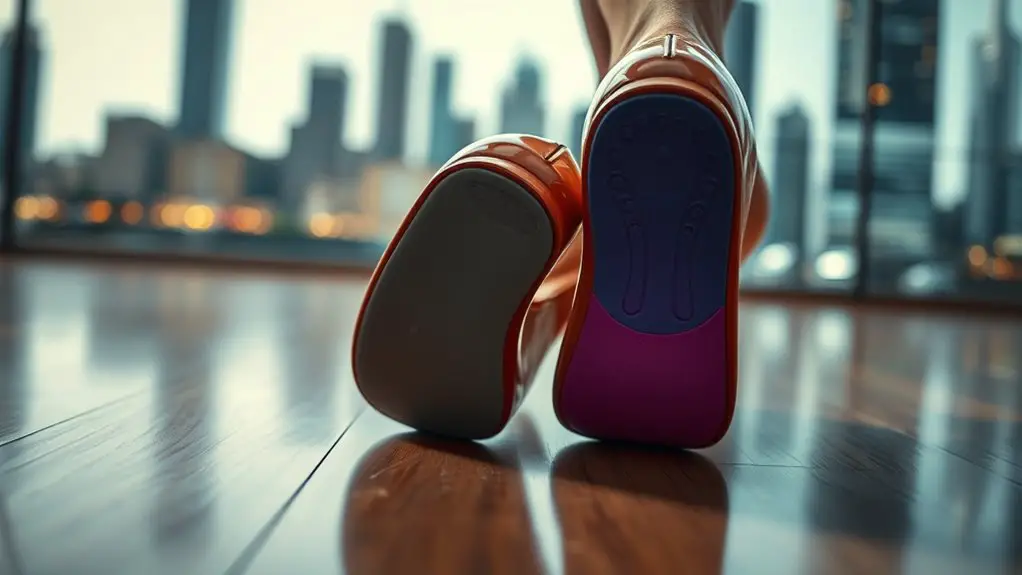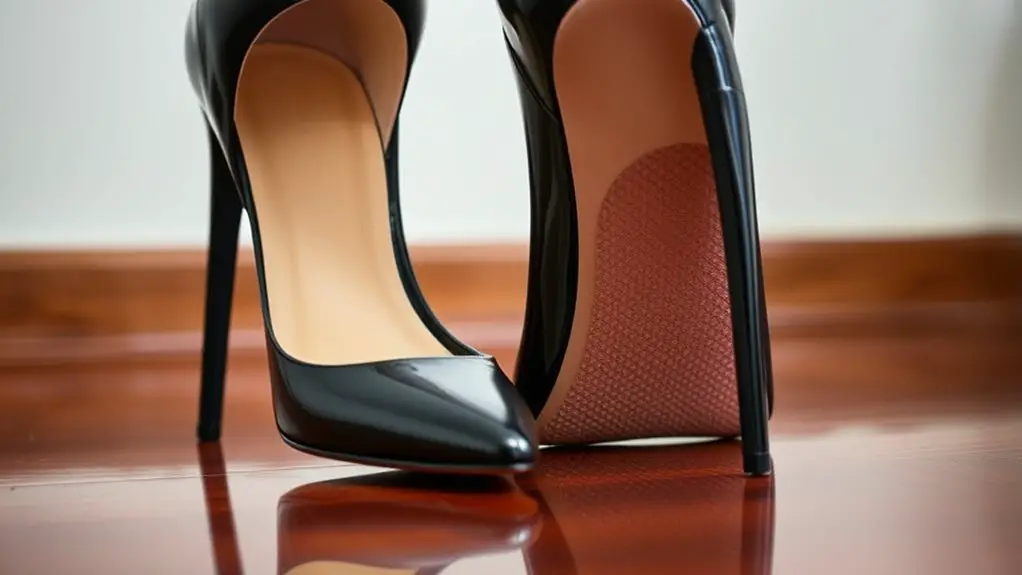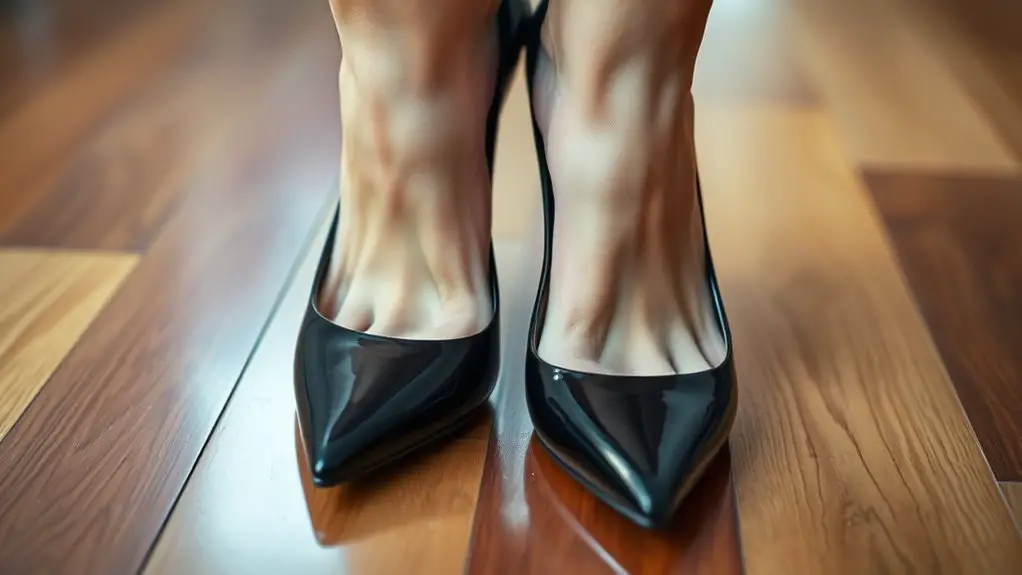For extra balance in high heels, choose insoles that offer strong arch support and effective cushioning. Materials like gel or memory foam can absorb shock and provide stability, essential for high heels. Look for non-slip surfaces to keep insoles in place, and adjust thickness based on your shoe style. If you’ve got high arches or flat feet, opt for insoles tailored to your foot type. Want to explore the top options and maintenance tips further? Keep going!
Understanding the Importance of Insoles in High Heels

When you slip into a pair of high heels, you may not immediately consider how insoles can enhance your comfort and support. The right insole materials, such as gel, foam, or orthotic options, can greatly impact your foot biomechanics. High heels shift your weight forward, altering your natural foot alignment and increasing pressure on the balls of your feet. This can lead to discomfort and pain over time.
Insoles designed specifically for high heels can mitigate these issues by providing additional cushioning and arch support. They help distribute your weight more evenly, reducing strain on your feet and lower back. Additionally, insoles can improve stability, allowing you to walk more confidently. By understanding the importance of insoles, you’re not just prioritizing comfort; you’re also investing in your foot health, ensuring that your stylish footwear doesn’t come at the cost of your well-being.
Key Features to Look for in High Heel Insoles
To guarantee maximum comfort and support while wearing high heels, you should pay attention to several key features when selecting insoles. First, consider the material types. Look for insoles made from breathable, cushioning materials like gel or memory foam, as they provide shock absorption and reduce pressure on your feet.
Next, assess the heel height of your shoes. Different heel heights require specific insoles. For higher heels, choose insoles that offer a more pronounced arch support to help distribute weight evenly. This feature can prevent discomfort and enhance stability.
Additionally, check for a non-slip surface on the insoles to keep them securely in place within your shoes. Finally, consider the thickness of the insoles. Thinner options may be better for snug-fitting heels, while thicker insoles can offer more cushioning in open-toed styles. Prioritizing these features will lead to a more comfortable high heel experience.
Top Insoles for Enhanced Stability in High Heels

When you’re choosing insoles for high heels, look for those with strong arch support features to maintain proper foot alignment and reduce fatigue. Additionally, cushioning is essential for comfort, helping to absorb shock with each step you take. Together, these elements enhance stability, allowing you to navigate your day with confidence and ease.
Arch Support Features
While you might love the elegance high heels bring to your outfit, the discomfort they often cause can’t be ignored. That’s where arch support features come into play. Proper arch support benefits you by distributing weight evenly across your foot, enhancing stability and reducing strain on your arches. When considering the right insoles, heel height considerations are essential; higher heels typically require more robust support to counterbalance the added pressure. Look for insoles designed with contoured arch support that can help maintain your foot’s natural alignment, minimizing fatigue and discomfort. This combination of arch support and thoughtful heel height can transform your high-heel experience, allowing you to strut confidently without sacrificing comfort.
Cushioning for Comfort
After ensuring proper arch support, the next key factor in enhancing your high-heel experience is effective cushioning. The right cushion types can greatly impact your comfort levels, allowing you to enjoy those stylish shoes without sacrificing your feet’s well-being. Gel insoles, for instance, offer excellent shock absorption, reducing pressure on the balls of your feet. Memory foam provides a customized fit, conforming to your foot shape and delivering exceptional comfort throughout the day. Additionally, air-cushioned insoles can enhance stability while providing a plush feel. When selecting an insole, prioritize those designed specifically for high heels, as they often combine various cushion types to maximize comfort and support, ensuring you can strut confidently without discomfort.
How to Choose the Right Insole for Your Foot Type
Choosing the right insole for your foot type is essential, as it can greatly enhance your comfort and support when wearing high heels. Start by understanding your foot anatomy—do you have high arches, flat feet, or a neutral arch? Each type requires different support levels. For high arches, look for insoles with added cushioning and a firm arch support, while flat feet benefit from stability and motion control features.
Consider the insole materials, too; memory foam provides personalized comfort, while gel offers shock absorption. If you experience discomfort, opt for a breathable fabric to keep your feet dry. You might also want to explore insoles specifically designed for high heels, as they often include extra padding and arch support tailored for a more upright position. In this way, you’ll find a suitable insole that aligns with your unique foot structure and enhances your overall experience in high heels.
Tips for Inserting and Adjusting Insoles in High Heels

When it comes to enhancing your high heels with insoles, choosing the right one is essential for ideal support. Make sure to insert them carefully to avoid disrupting the fit of your shoes, and don’t hesitate to adjust them for maximum comfort. The right approach can transform your experience and keep you on your feet longer.
Choosing the Right Insole
How can you guarantee your insoles fit perfectly in your high heels? Start by selecting the right insole materials that match your foot arch. For example, if you have a high arch, look for insoles with extra cushioning and support to prevent discomfort. Conversely, if you have flat feet, opt for insoles that offer stability and help distribute pressure evenly.
Measure the insoles against your shoes, ensuring they’re not too long or wide. Trim them if necessary, making small adjustments gradually. Remember, the goal is to maintain a snug fit without compromising comfort. Finally, consider the heel height of your shoes; a thicker insole can alter your balance, so choose wisely to enhance stability while wearing your favorite heels.
Inserting With Care
Inserting insoles into high heels can markedly enhance comfort, but it requires a careful approach. First, select the right insole materials that match your needs, whether it’s gel, foam, or arch support. When you’re ready to insert, remove the existing insole, if applicable, to create a proper fit. Align the new insole with the heel and toe sections, ensuring it sits flat. For ideal stability, employ fitting techniques like trimming the insole to prevent bunching. You might also want to experiment with different thicknesses to find what works best for your foot shape and heel style. Taking these steps can make a significant difference in how you feel while rocking those heels.
Adjusting for Comfort
After carefully inserting the insoles, the next step is adjusting them for ideal comfort. Start by making sizing adjustments; trim the insoles if they’re too long. Confirm they fit snugly without bunching up. Next, consider material choices that suit your needs. Gel insoles provide cushioning, while foam offers support.
Here’s a quick comparison to help you choose:
| Material Type | Benefits |
|---|---|
| Gel | Excellent shock absorption |
| Foam | Lightweight and supportive |
| Leather | Breathable and durable |
Experiment with different configurations to find what works best for you. A little fine-tuning can greatly enhance your comfort and stability in high heels, making your experience enjoyable without compromising on style.
Customer Reviews: Real Experiences With High Heel Insoles
Customer feedback offers valuable insights into the effectiveness of high heel insoles, revealing how they can transform your experience with stylish footwear. Many users report a significant reduction in discomfort, allowing them to wear heels for longer periods without pain. They appreciate how these insoles provide extra cushioning and arch support, which helps distribute weight evenly.
User experiences often highlight the enhanced stability that high heel insoles deliver, making it easier to navigate tricky terrains, like cobblestones or uneven surfaces. Some customers mention that certain brands even improve the fit of their heels, preventing slipping and blisters.
Maintaining Your Insoles for Long-lasting Comfort
To guarantee your high heel insoles provide long-lasting comfort, it’s essential to adopt a regular maintenance routine. Start with insole cleaning; gently remove them from your shoes and wipe them down with a damp cloth. Avoid harsh chemicals that could degrade the material durability. If your insoles are machine washable, follow the manufacturer’s guidelines carefully, ensuring they’re air-dried completely before reinserting them.
Check for signs of wear, like cracks or thinning. If you notice any damage, it’s time to replace them to maintain ideal support. Additionally, store your shoes in a cool, dry place to prevent moisture buildup that can affect both the insoles and the shoes. Finally, regularly rotate your heels to avoid excessive pressure on any single pair of insoles, prolonging their lifespan and ensuring your comfort. Keeping up with these practices will help you enjoy your high heels without compromising on support.
Frequently Asked Questions
Can Insoles Improve Posture While Wearing High Heels?
Yes, insoles can enhance your posture alignment by providing heel stability, which helps distribute weight evenly. This support reduces strain on your feet and spine, allowing you to maintain better posture while wearing high heels.
How Often Should I Replace My High Heel Insoles?
You should replace your high heel insoles every 6 to 12 months, depending on wear and tear. Regularly checking their condition guarantees peak support, comfort, and performance, preventing potential foot issues from worn-out insoles.
Are Insoles Suitable for All Types of High Heels?
Not all insoles fit every high heel type, as comfort levels can vary considerably based on heel shapes. You’ll want to choose insoles that cater specifically to your shoe’s design for ideal support and balance.
Do Insoles Add Extra Height to High Heels?
Insoles can provide height enhancement by adding additional lift inside the shoe. They also improve heel comfort, helping distribute pressure more evenly, which can make wearing high heels for extended periods more enjoyable without sacrificing style.
Can I Customize Insoles for Specific Foot Conditions?
If your feet aren’t feeling their best, you can certainly explore custom insole options. A thorough foot condition assessment can help identify your specific needs, leading to solutions that enhance comfort and support for your unique requirements.



